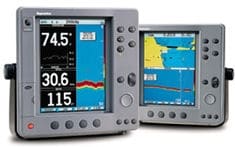
| Depthsounders with large, bright, sunlight-viewable displays and split-screen capability – such as Raymarine’s L1250 – are becoming the point where skippers gain access to information from their entire array of marine electronics. |
Depthsounders, fishfinders, bottom machines, echo sounders – by any name this valuable piece of equipment occupies center stage on the helm of almost every fishing boat. The recent trend in depthsounder technology has been toward color, compactness and answering the space demands of smaller center consoles. To this end, manufacturers have created products that are nothing short of remarkable, but there are still plenty of fishermen out there who don’t have to cram equipment into a limited amount of space.
In the past, big-boat anglers looking for the ultimate in depthsounder technology often went with commercial machines – those designed for commercial fishermen or scientific research. Nowadays, that’s no longer necessary. Many manufacturers offer big sounders with the same features and state-of-the-art technology that are used in commercial units, but which are designed, configured and priced specifically for the sport-fishing market.
So, why is bigger better? The most obvious reason is screen size. A larger screen gives you a bigger picture of what’s below the boat. The images are larger and more detailed. For example, you don’t have to strain your eyes or spend extra time zooming in to make out the image of a fish holding next to a ledge or wreck. It’s easier to see minute changes in bottom structure and the details of wrecks and reefs. Bigger images are also easier to see from a greater distance, a major benefit when operating from the helm of a large boat or if you need to check the sounder from the cockpit. And if you need to zoom in on a target, a bigger screen gives you more detail of the expanded images.
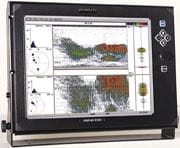
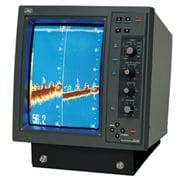
(top) Simrad’s ES60 sounder offers sophisticated transceiver configurations that provide anglers with the precise sizes and locations of individual fish. (bottom) The JFV-130 from JRC has a 12-inch color screen and allows the user to save optimum settings for three different fishing situations.|
But there’s another reason why a large screen is beneficial, and it has to do with the recent trend toward electronics integration. More and more boaters are linking their various onboard electronics so they can access information from multiple sources on one screen. In many cases, the depthsounder serves as the “point man” in this system, allowing the helmsman to view all vital information on its screen. In other words, the sounder screen can be used to display radar, GPS, chart plotter information and more.
Universally, this is accomplished by a split-screen display. For example, one side of the screen can be used to display depthsounder information while the other shows radar. Or the screen may be divided into three or four segments each displaying different information. Obviously, a larger screen provides more room for split-screen functions, and can display larger, clearer and more detailed images.
Raymarine is one company that’s on the cutting edge of sounder technology. In fact, its Fort Lauderdale office is dedicated strictly to depthsounder development. The New Hampshire-based company chose the Florida city for its sounder operations because its products can be tested on the ocean year-round. Field-testing and product development get a real leg up when new product can be in the lab in the morning and on the water that afternoon. Add to the convenience the fact that just about all the designers and engineers at the Florida facility are serious fishermen, and good things are bound to happen.
Recently, we had an opportunity to tour the Fort Lauderdale facility and had a firsthand look at Raymarine’s biggest depthsounder – the L1250 Fishfinder. For starters, the L1250 sports a 10.4-inch LCD screen. It provides a big, color picture of what’s below the boat, but the giant screen really shines in the split-screen mode.
We took the L1250 on a test drive off Fort Lauderdale, and the results were impressive. In the open cockpit of the test boat, the fact that we were in full sunlight at noon did nothing to inhibit viewing of the image on the sounder display. When you choose to zoom in on a bottom feature or a particular fish, you can really zoom in, to two-, four- or six-times magnification. During our test run, a mark that looked like a single fish, for instance, turned out to be four separate fish when we zoomed in on it.
In many cases, the bigger screen gives you a much better idea of what you are looking at and how big it really is. There’s simply more room to zoom. Add to this the ability to display 200 kHz (for shallow-water resolution) and 50 kHz (for deep-water penetration), either individually or simultaneously, and you have a tremendous amount of information at your fingertips.
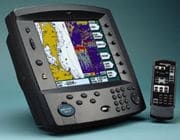
Northstar’s 957 works with the company’s black-box 490 sounder.|
To show off its interfacing capability, our L1250 was linked to other onboard electronics via the Raymarine hsb2 (high-speed bus) networking system. One by one, we added additional information to the sounder screen, starting with data from the chart plotter. Now the course we had just followed was clearly visible on half the screen. Placing the cursor on a part of the course allowed us to access data for that particular spot, including depth, echo returns, bottom features and surface temperature. Next we added the radar, which allowed us to see radar images on one side of the screen, and either sounder or plotter info on the other. With a press of a button, we could even overlay the radar image on top of the plotter!
Raymarine’s integration system relies on linking individual instruments to provide combination data displays. Other manufactures handle this in various ways, ranging from factory-tuned combo units to “black box” instruments without a screen that simply provide data to a display of your choice.
Total integration of all systems is the name of the game when you have plenty of room aboard to handle the hardware. Raymarine is building its latest instruments from the ground up around the large-screen sounder. However, other manufacturers have their own take on the same functions, and they merit some attention if you plan on outfitting your boat with the latest in anti-fish intelligence equipment.
Case in point: The Furuno FCV 1200L and FCV1100 are large-screen (10.4-inch) sounders that feature the Free Synthesizer Transceiver, which allows you to tune to a complete choice of frequencies to match any number of transducer configurations. Low frequency, high frequency or dual frequencies are possible, and display options allow different colors for particular frequency returns, which allows you to tell species apart on the display. Split-screen capabilities and custom screen layout give you more options than you’ll likely ever use, but make sure you can configure it to fulfill your particular desires.
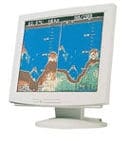
Furuno’s FCV 1200 BB puts fishfinder functionality on nearly any display. |
Black box systems, available in the FCV1200, allow the use of either LCD or more traditional CRT monitors. The FCV 1100 has all the same capabilities, but it is a self-contained unit, integral with the 10.4-inch screen. Networked electronic functions fall under the NavNet umbrella, the Furuno product line dedicated to interactive data systems with its own networking protocol.
Always a leader in navigation, Northstar has recently introduced the 490 sounder, a black box option for the 957 and 962 GPS/chart plotters. Display modes on the 10.4-inch screen can be selected for split-screen viewing with the plotter, and either 50 and 200 kHz echo return, or both. Past echoes may be marked as a waypoint and called up later for reference. The sounder has a depth range of 2,000 feet. Basic navigation data is always displayed at the bottom of the screen.
Simrad offers a couple of PC-based sounders that come turnkey with a marinized PC. The EQ60 operates on Windows 2000 and the ES60 on Windows NT. Both are dedicated systems, not open architecture software. The ES60 has a split-beam option, which means it can accommodate transducers with four beams and/or frequencies, from 12 to 200 kHz. This allows you to determine both the relative size of the fish indicated and the exact position of the fish in relation to the boat – something that becomes critical in deeper water as the coverage cone expands.
The ES60 system is supplied with or without a 15-inch monitor. Without, it can be hooked up to virtually any LCD screen you choose, just like a PC. The EQ60 is a more conventional sounder, with three frequencies: 38, 50 and 200 kHz. Both models offer power output of 1,000 watts per channel. Integrated and networked electronics at Simrad are factory-configured. Sounder, plotters, radar networks or any combination thereof, are assembled prior to shipping.
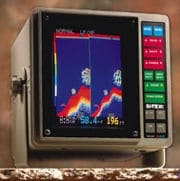
The SI-TEX CVS-210 offers dedicated fishfinder capability with 22 depth ranges to 3,000 feet.|
Japan Radio Company (JRC) offers three powerful models designed for larger boats. The JFV-700 with ten-inch screen is available in 1kW or 3kW (called the 700HP) versions that feature simultaneous display of two images, and three types of bottom or fish species can be stored in memory. The high-speed transducer pulses enable small fish near the surface to be clearly detected. The JFV-130 (available in horizontal format as the JFV-131) has a 12-inch, high-resolution, 16-color screen; high-speed pulse, and will also store three species/grounds setups in memory. The JFV-240 is a big 14-inch, high-resolution unit available in optional 5kW and 10kW power for deep-water use and features A-scope display, water-temp graph, four-setup memory and video compression whereby up to four hours of image can be displayed on a single screen. A wireless remote control is available as an option.
A true dual-frequency depthsounder, the CVS-211 from SI-TEX has a ten-inch CRT display that supports the sounder and track-plotter functions, displaying them on a split screen. It has 1,000 watts of power output and 22 basic depth ranges from one to ten feet down to 3,000 feet. Of particular interest is the DepthGraph feature, which allows the storage of 200 waypoints that include depth, bottom contour and surface temperature. It’s an electronic version of a paper recorder’s history. The points saved in memory can also be used to create a graph of depth and temperature covered throughout the day. Track color on the plotter can also be configured to indicate depth or water temperature. The CVS-210 is another version that functions as a depthsounder only.
| For more information:Furuno USA, Camas, WA; (360) 834-9300; www.furuno.com ¿ Northstar Technologies, Acton, MA; (978) 897-0770; www.northstarmc.com ¿ Raymarine, Nashua, NH; (603) 881-5200; www.raymarine.com ¿ Simrad USA, Lynnwood, WA; (425) 778-8821; www.simradusa.com ¿ JRC, Seattle, WA; (206) 654-5644; www.jrcamerica.com ¿ SI-TEX, St. Petersburg, FL; (727) 576-5734; www.si-tex.com |









